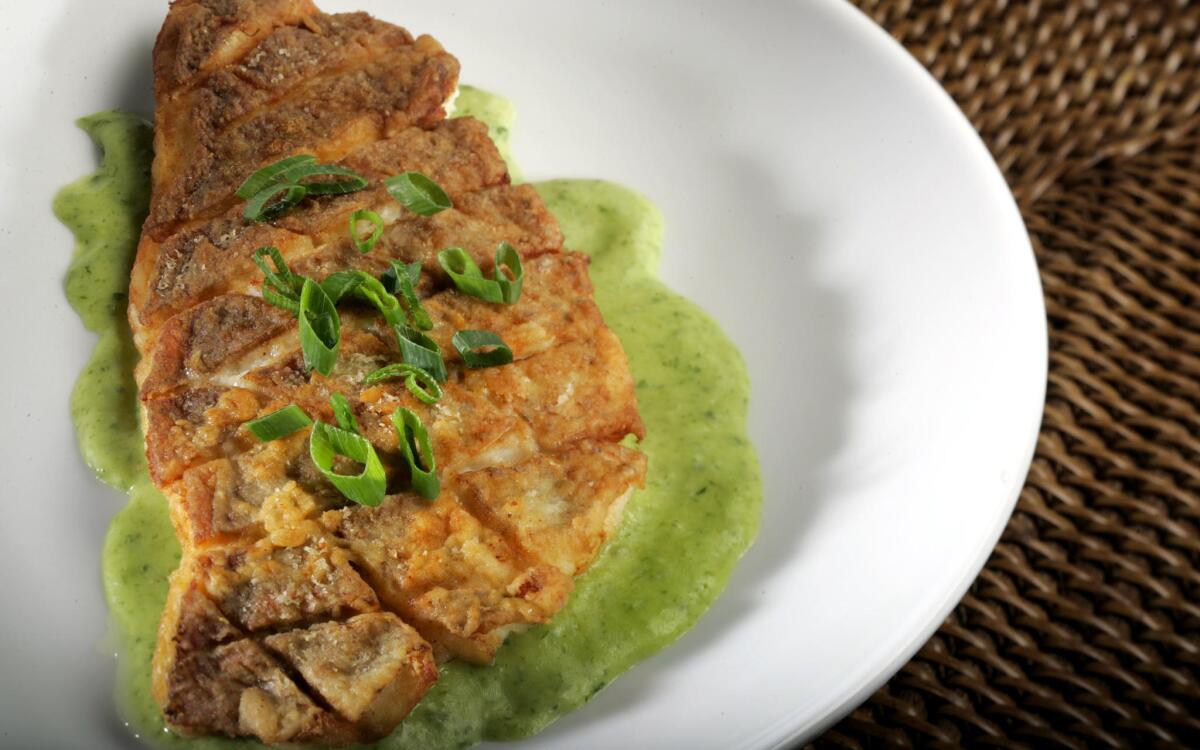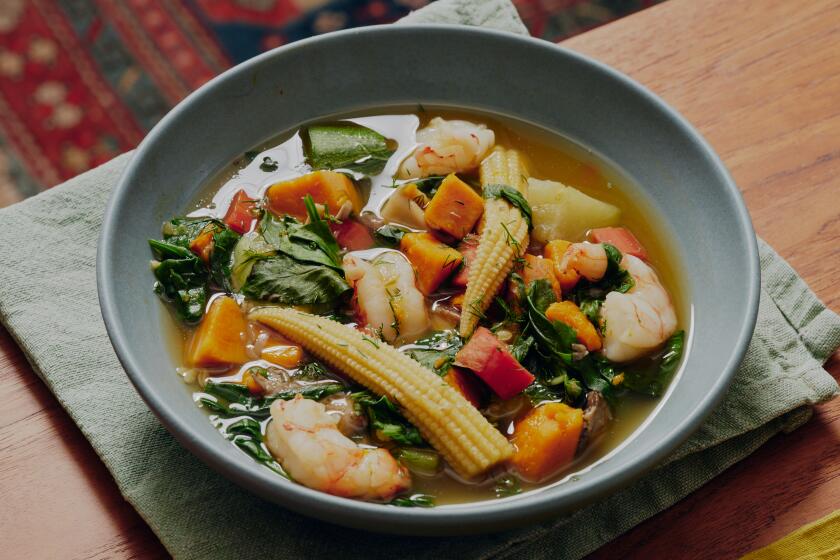Jasper's half-crispy fish with green onion puree

- Share via
For reasons I would not want to repeat, I recently enjoyed a couple of weeks of being cooked for by a consort who was happy to shop and chop and even do dishes if only I would tell him what to make (and not how to clean up). Usually there was no argument. I wanted fish because it was good and light for me as I was getting my feet back under me, and he agreed because it was fast and easy.
It was a lovely respite. I found myself pulling out all my old super-simple recipes and handing them over in the hopes of an early dinner. And he, who normally finds the most complex formula in the most esoteric cookbook when I’m there to help, happily followed them. If he had to make the salad and the vegetable too, speed counted for more than daring.
Coming up with ideas was no problem. These are the kinds of recipes that get us over the Thanksgiving food hangover, when we’ve had our fill of heaviness, and through the next few harried weeks. (Who has time for stewing and braising when there’s shopping to be done and tips to be doled out?)
Oddly enough, many of my favorites have been gleaned from chefs’ vanity books, not the places most frenzied cooks go looking for speedy ideas. But a surprising number have at least one great, adaptable technique, a trick only a chef would know. From Norman Van Aken’s first book, for instance, I learned the secret of grouper: Sear it in oil on top of the stove for two minutes, then finish it in a 500-degree oven. That method works even better with salmon steaks in a cast-iron skillet, with no oil at all. Either is flavorful enough to lie naked on a plate, but you can sauce them with salsa or just a glaze of coarse-grain mustard.
The night Bob walked in with my least favorite fish, red snapper, I remembered an amazing recipe from a Jasper White cookbook, from back when he was at the forefront of the New American movement at Jasper in Boston. All it entailed was dipping the skin side of the seasoned fillets in milk, then dredging it in flour and laying the fillets in hot oil in a covered skillet. The skin turned crusty-crispy while the flesh stayed moist, and all in about seven minutes.
Those fillets were spectacular, but I thought they needed something, a drizzle of tamari or balsamic vinegar at least. Next time my private chef came home with snapper I looked up the actual recipe and saw that it included a scallion puree. Making it adds only another couple of steps but transforms the fish.
Our all-time favorite for mindless perfection is flounder, transformed with a Pierre Franey technique from the tattered “60-Minute Gourmet” cookbook we have had for as long as we have had each other. A combination of mayonnaise and Dijon mustard is brushed over the fillets before you broil them for two or three minutes. It’s like a built-in sauce, and the fish is always super-juicy under the bubbling crust. The original recipe calls for chopped parsley, and sometimes I substitute chives, but Bob has often gone his own way with a few chopped walnuts and some bread crumbs.
So far we haven’t gotten around to one of the best fish-in-a-flash ideas I’ve ever come across, one so impressive I have served it many times at dinner parties when I needed a main course that could be assembled ahead of time and finished without much attention. It uses boneless trout fillets. Sure, they’re farmed, so not exactly flavorful on their own. But the topping of pancetta, shallots, capers and sage spooned over them is so vibrant that you don’t even long for something wild.
Green onion puree
Start making the green onion puree about 30 minutes before cooking the fish. Cut the green onions in half crosswise, separating the white part from the green. Place the white halves in a medium saucepan with 3 tablespoons butter and 2 tablespoons water. Simmer very slowly until tender, about 10 minutes. Add half of the green portions (reserving the remaining green portions for garnish) and cook for one minute.
Remove from the heat and puree in a blender or food processor. Pass the puree through a coarse strainer into a clean saucepan, pressing on the onions with the back of a rubber spatula. Discard the onion solids remaining in the strainer.
Rewarm gently as the fish is cooking, adding a little water to thin the sauce consistency, if necessary. Just before serving, stir in the remaining butter. Season with the vinegar and salt and pepper to taste. Makes one-half cup sauce.
Fish
Score the skin of each fish fillet, making lines about three-fourths of an inch apart and cutting into the flesh as little as possible. Carefully dip the skin side of each fillet first into the milk, then into the seasoned flour. Repeat. Continue with remaining fillets. Do not get any flour on the flesh side of fish.
Pour peanut oil to a depth of one-fourth of an inch into large saute pan (or 2 saute pans) and heat over medium heat. Lay fillets in, skin side down. Cover the pan loosely with a lid or pie tin. The fish should be sizzling. (While skin is crisping, flesh is steaming.) Cook 5 to 7 minutes, until a very sharp knife inserted into the thickest part of fillet pierces easily.
Spread the green onion puree over four plates and lay each fillet, skin side up, on top of the puree. Thinly slice the reserved green onions on the diagonal; sprinkle over the fish.
Get our Cooking newsletter.
Your roundup of inspiring recipes and kitchen tricks.
You may occasionally receive promotional content from the Los Angeles Times.















